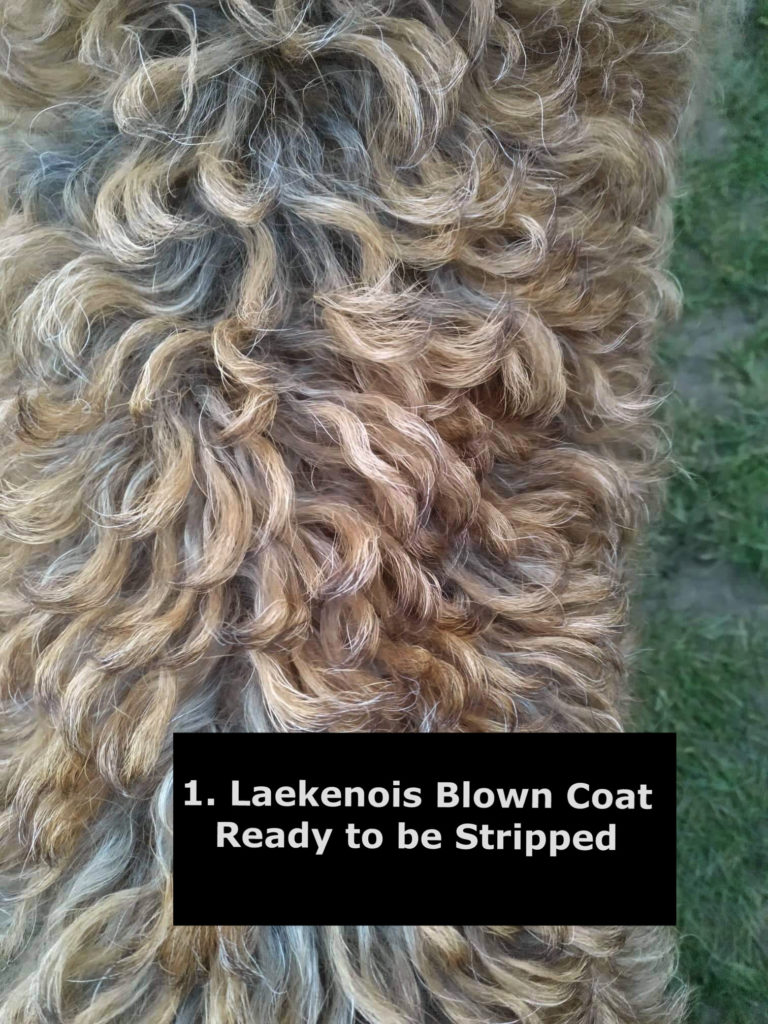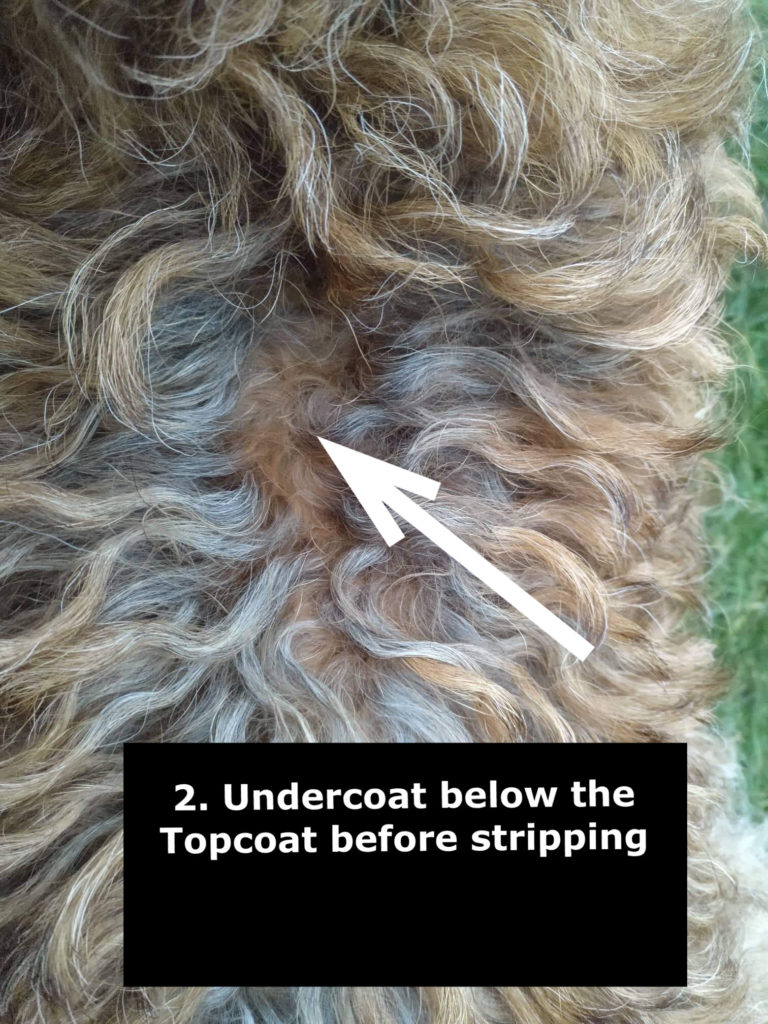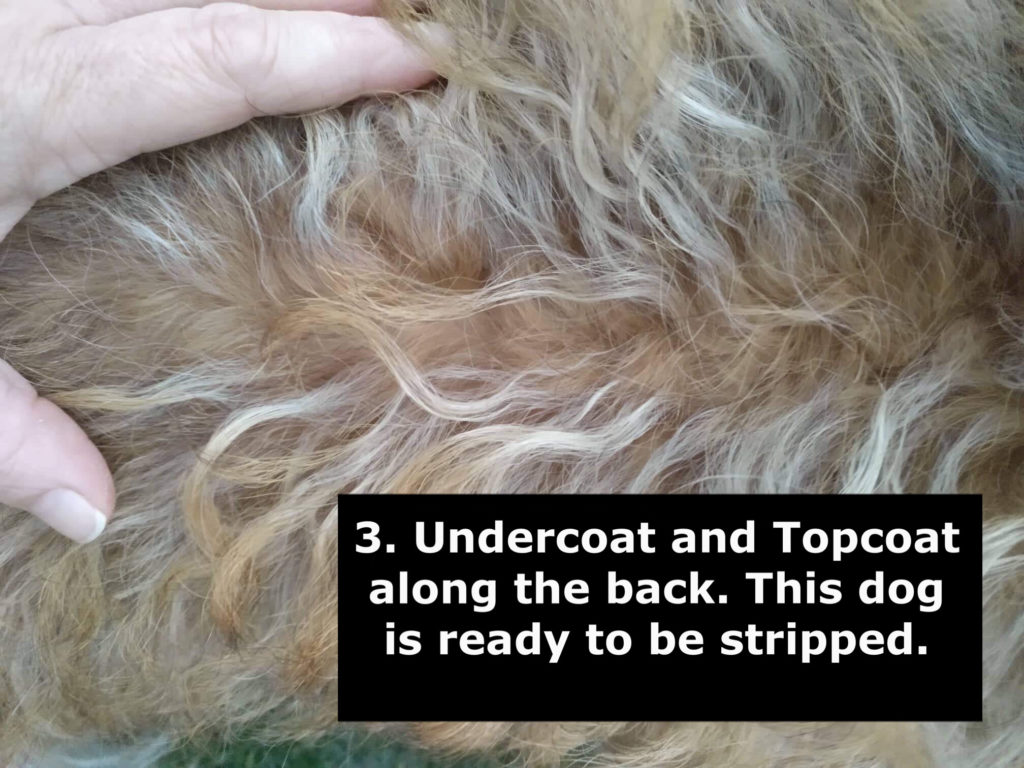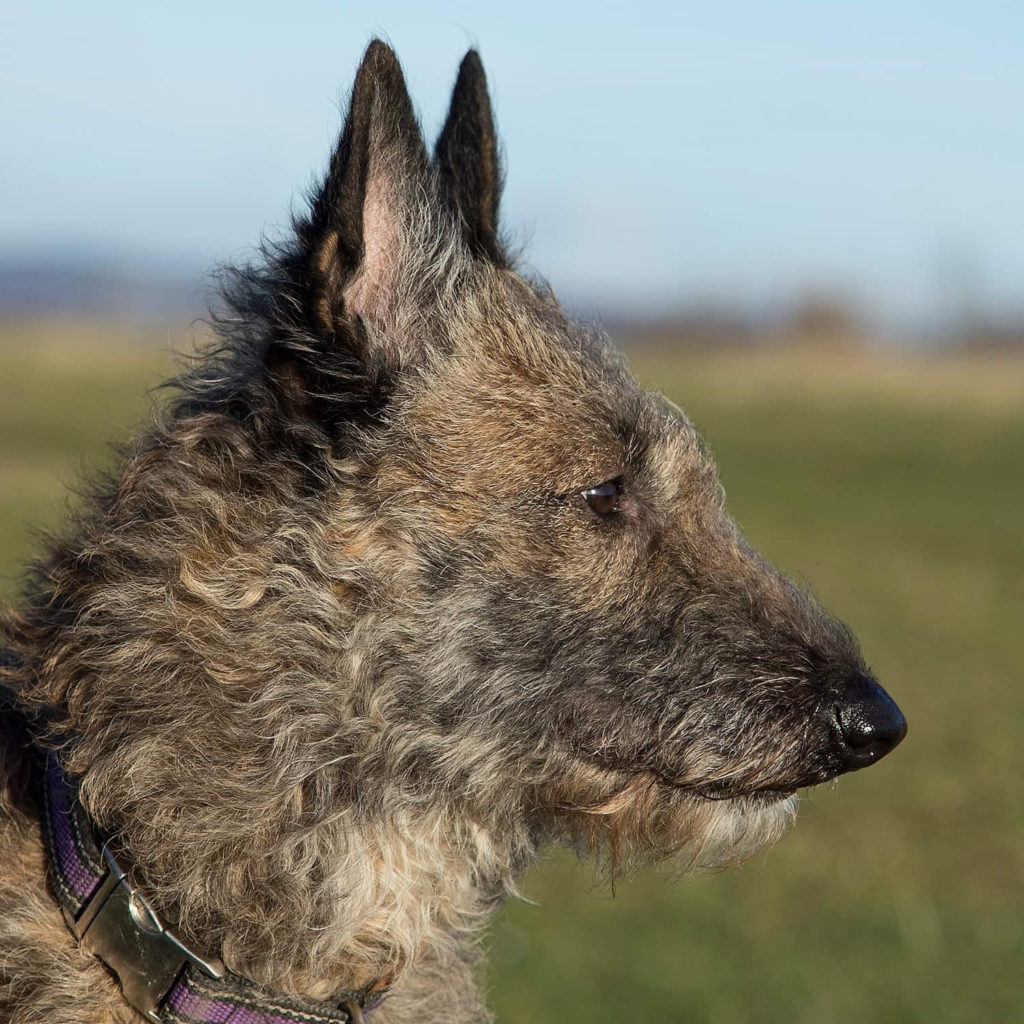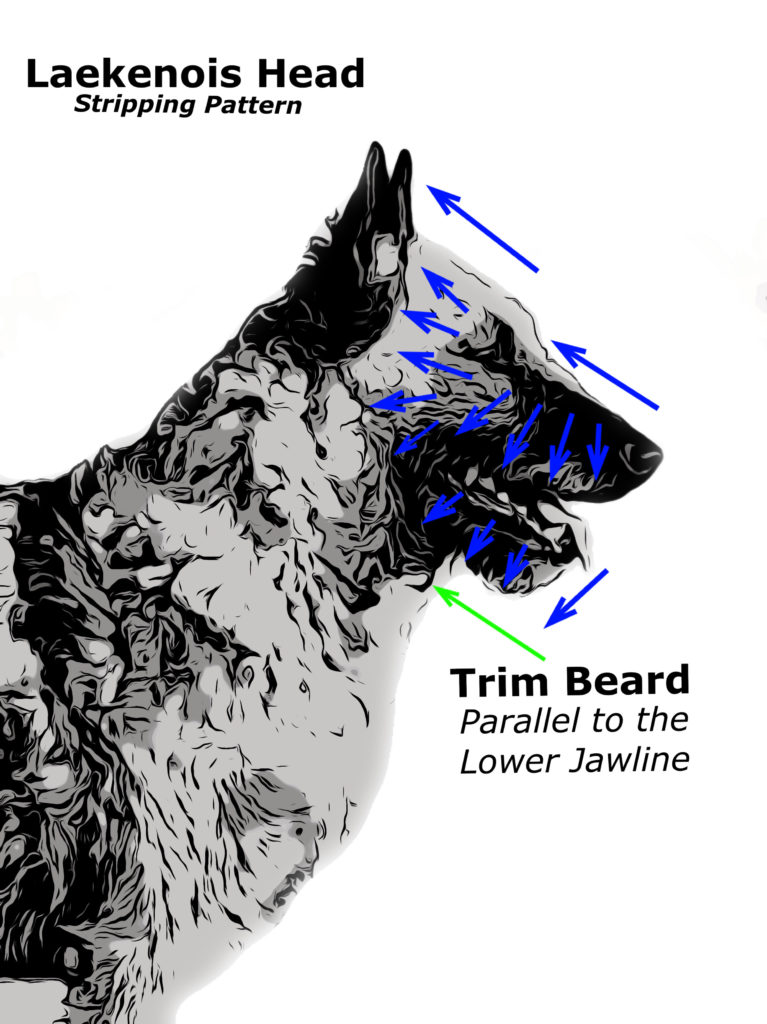Let’s review the key coat elements of the AKC Breed Standard that make the Laekenois a Laekenois and not another breed of dog. Each one of these items have grooming issues to be addressed so that the presentation of the Laekenois is proper in the Conformation Breed Ring.
The key items are as follows:
- Rough and Coarse
- Disorderly, Tousled
- 2½ inches over the body
- Beard must be present on the muzzle
- Head should not be in excess so as to hide the eyes nor the lines of the head and skull
- Tail should not form a plume
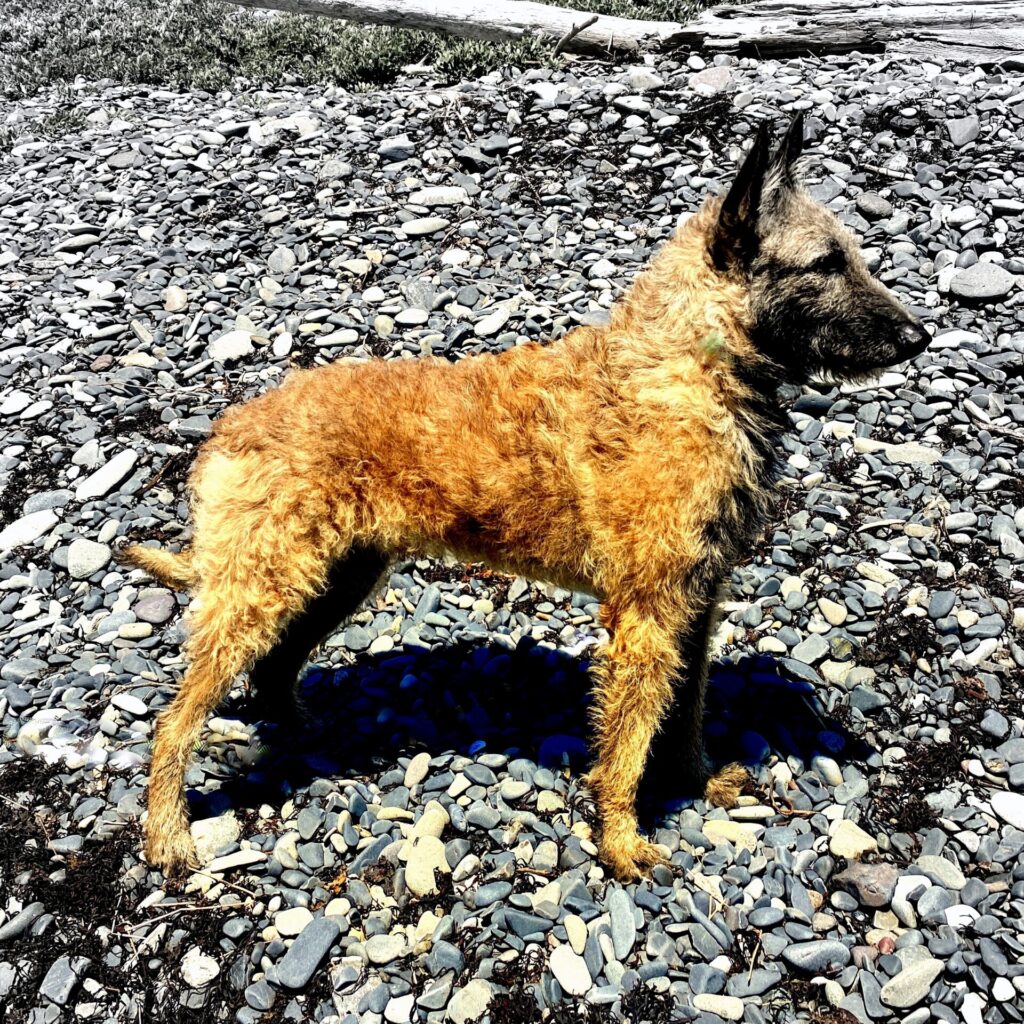
Rough and Coarse
Coat Preparation, bathing is done infrequently, in order to bathe the coat to maintain a coarse texture, a harsh coat product should be selected and no softening conditioner should ever be applied. There are harsh coat products on the market or Dawn dish soap applied diluted with a wet sponge rather than applying the product directly to the coat is an effective method. A rinse with watered down Listerine will also keep the coat crisp. Always rinse your Laekenois thoroughly, as the rinse is the most important portion of the wash cycle, for your laundry and your dog.
Disorderly, Tousled
The disorderly tousled aspect requires less work rather than more. Scissoring, Shaping with Shears, Clipping od the jacket of a Laekenois is in direct conflict with the AKC Breed Standard. Utilizing any of these techniques to carve an outline of a Laekenois is unacceptable.
Scissoring the bottom of a Laekenois feet to assure traction is acceptable. Scissoring on the belly/gentiles. Stripping to maintain the bottom line of the beard is the proper method.
2½ inches over the body
The 2½ inches is achieved by proper stripping timing. Generally Laekenois are stripped twice a year, planning the appropriate grow out time to assure 2½ inches of coat will vary by individual. Some is is 3 months in advance others it is 6 weeks. Check with others who own dogs of similar lineage and coat variation to learn what timing works best.
Beard must be present on the muzzle
Beards are either there or not. Stripping them as part of the head strip process which occurs a few weeks after the initial body stripping process to assure the head hair length is shorter than the body. To put it simply always leave enough beard. Stripping to maintain the bottom line of the beard in parallel is appropriate.
Head should not be in excess so as to hide the eyes nor the lines of the head and skull
Stripping the head is done closer into the time of showing, or redone after a full body strip to assure that the rate of hair growth on the head meets the appropriate timing for the shorter length desired. The appearance of the head is achieved by stripping, not scissoring or clippering. Depending on the dog a strip of the head can be 4 – 6 weeks in advance of the show.
A Plume tail, what is it?
Dogs with plumed tails could be examples of Belgian Tervuren, Saluki or even Borzoi.The Laekenois’ tail does grow coat, the tail hair should also be hand stripped, this is the only acceptable method for neatening the tail.
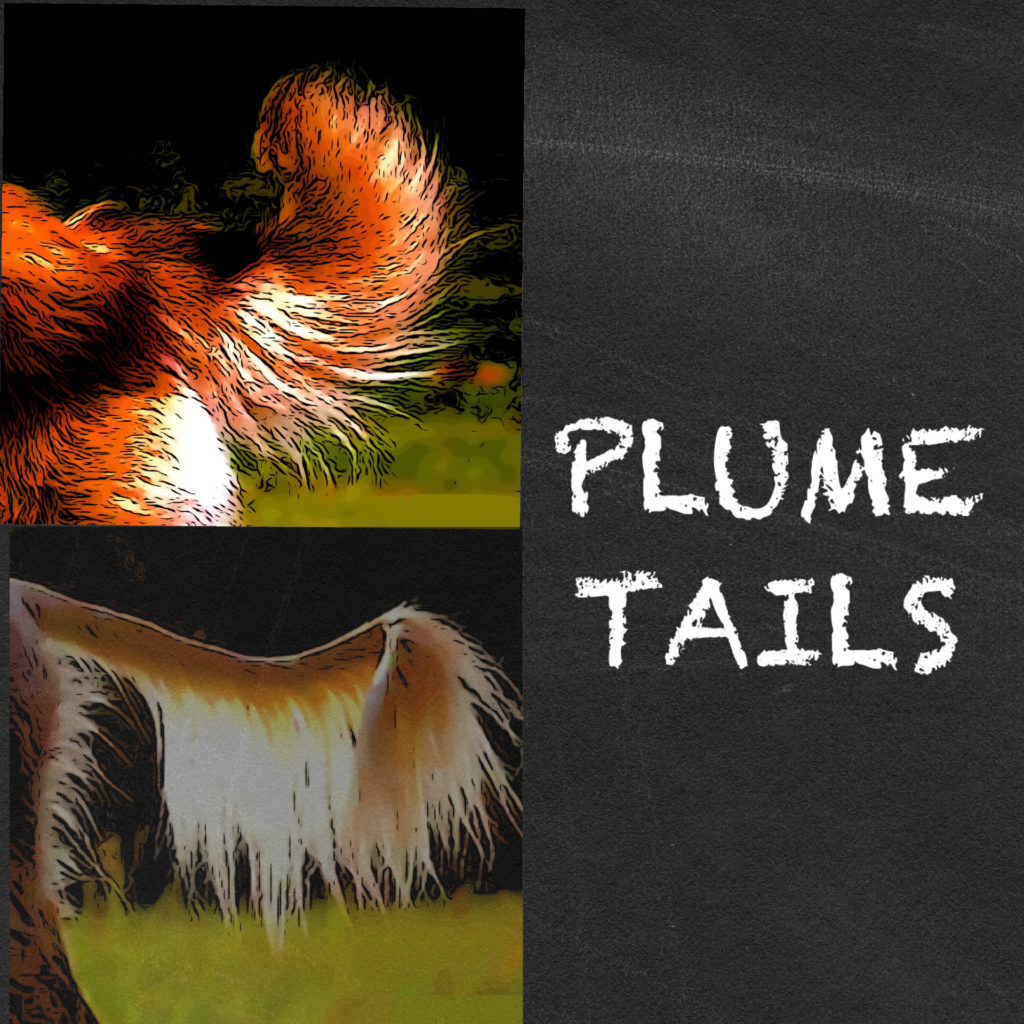
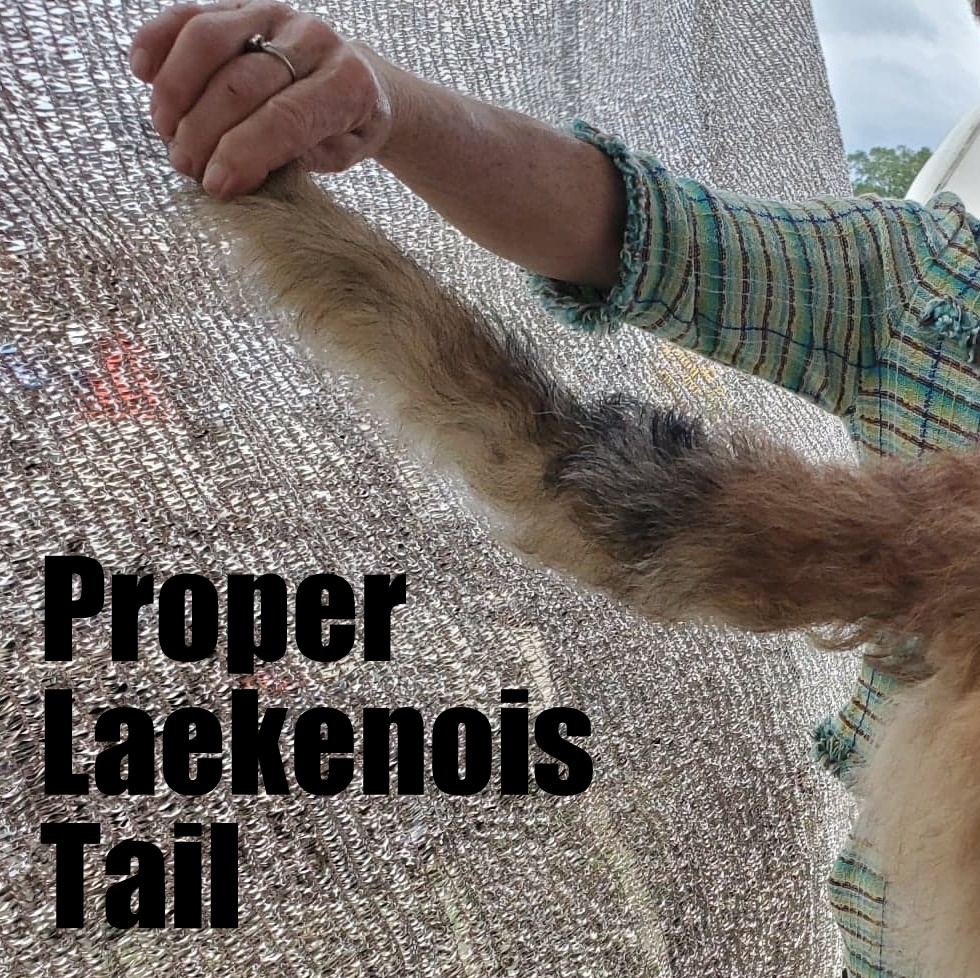
First Things First
Is my Dog ready to Strip?
Have a look at the coat and see what the condition is. Below are photos that a good reference to determine whether your dog’s coat is “blown”. A blown coat is one where the hair has essentially run it’s course and needs some help going through the shedding process. When the hairs are pulled, it should release easily and cause no pain. If it is difficult to pull or your dog tells you it is painful then stop. The coat is not completely blown and not ready to be stripped.
Making a Plan
- Calendar 8-10 weeks ahead of the show to begin your stripping process, Alternatively calendar to strip your Laekenois every 6 -10 months. The schedule is based on your preference with your dog’s coat and your needs.
- Do not use scissors or clippers on the Laekenois Body, Face or Legs. Scissoring is acceptable around the gentiles and on the bottoms of the feet around the pads, to provide for better traction. The Lower Beard is stripped with a rolling strategy to make the beard parallel to the lower jaw.
- The preferred method is to hand strip the Laekenois
- The use of a stripping knife is not preferred it will cut and break the coat. This is very important considering that the color on the hair shaft is at its best in the first 6 cm or 2 1/2”, at a longer length the hair is lighter in color. Breaking the coat will cause a pale, frayed coat.
- 1 Hour of Grooming is the best plan for comfort of your dog, this time will be able to be extended as your Laekenois understands the process.
- Don’t expect your dog to stand for a full hand strip in one session for the first effort, so plan this project for a few days with a few grooming blocks, not an all day marathon session
- Pay attention to your dog he/she will tell you when they have had enough, usually an hour is more than enough at one go. As dogs mature they actually can look forward to this grooming, and fall asleep on the grooming table
- The process can be a few hours but keep in mind the stripping only occurs once or twice a year. So overall the time commitment for upkeep is not that great.
TAIL and JACKET
- When stripping, pull the hair aft or down, not up or forward. It is more comfortable for your dog when the stripping is done in the direction of growth. If standing at the rear and side of the dog, with one hand hold the dog’s skin forward of where you are stripping by and inch or two firmly enough so that the skin’s motion is limited when you pull on the hair. Essentially, you are steadying your work area. With your other hand, take a few hairs between the thumb and index finger and pull the hairs out with a firm and quick motion in the direction the coat grows. Strip the coat evenly, making sure to keep the skin steady as you strip. Less is more when stripping. You are better off to take fewer hairs as you work as it is more comfortable for the dog. Less is more in stripping.
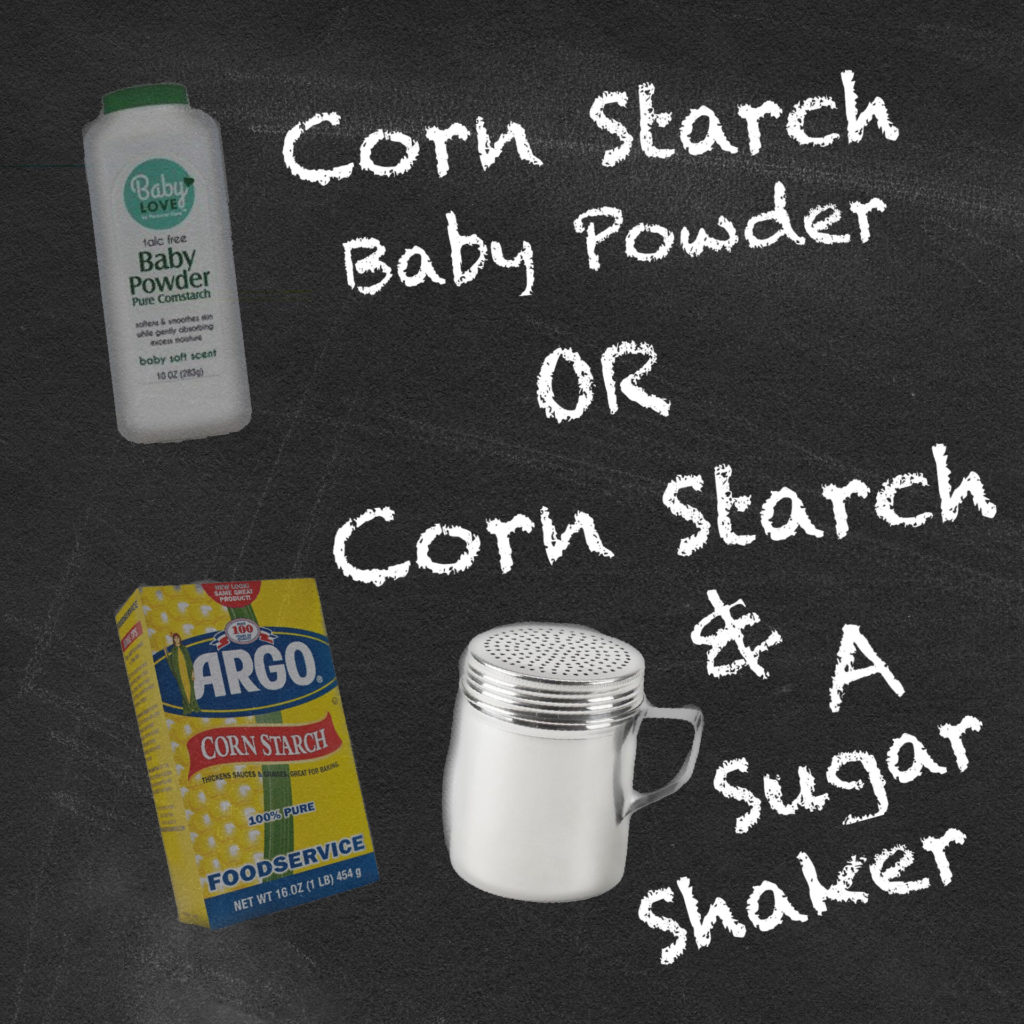
Have corn starch at the ready, it can assist in your ability to grip the coat, a powdered sugar shaker is a good method to apply the corn starch or purchase pure cornstarch powder in the baby powder section of the store

Finger Cots are a helpful tool when hand stripping. Wearing finger cots on thumb, index and middle fingers will allow for a better grip of the coat throughout the stripping process.
WHERE TO BEGIN
There are two potential starting points for stripping your Laekenois. From the front or from the tail
- FROM THE TAIL FORWARD – To begin at the tip of the tail to begin your work stripping. Work in a methodical orderly manner as you move forward pulling the top coat only with your hands, it should give and pull easily. Continue to strip down outside of the rear legs and then move forward up the back and sides. Do the same for the undercoat.
- FROM THE HEAD BACKWARD– Start at the back of the head behind the occiput at the top of the neck and work aft towards the tail. Working to make either a strip down the back or working in a fan pattern that works from either side of the neck and expanding the width of the fan as you move to the shoulders and toward the tail. Wrap the stripping around the chest and neck so that the entire dog grows in at the same length of 2½ inches overall by the time the dog enters the show ring.
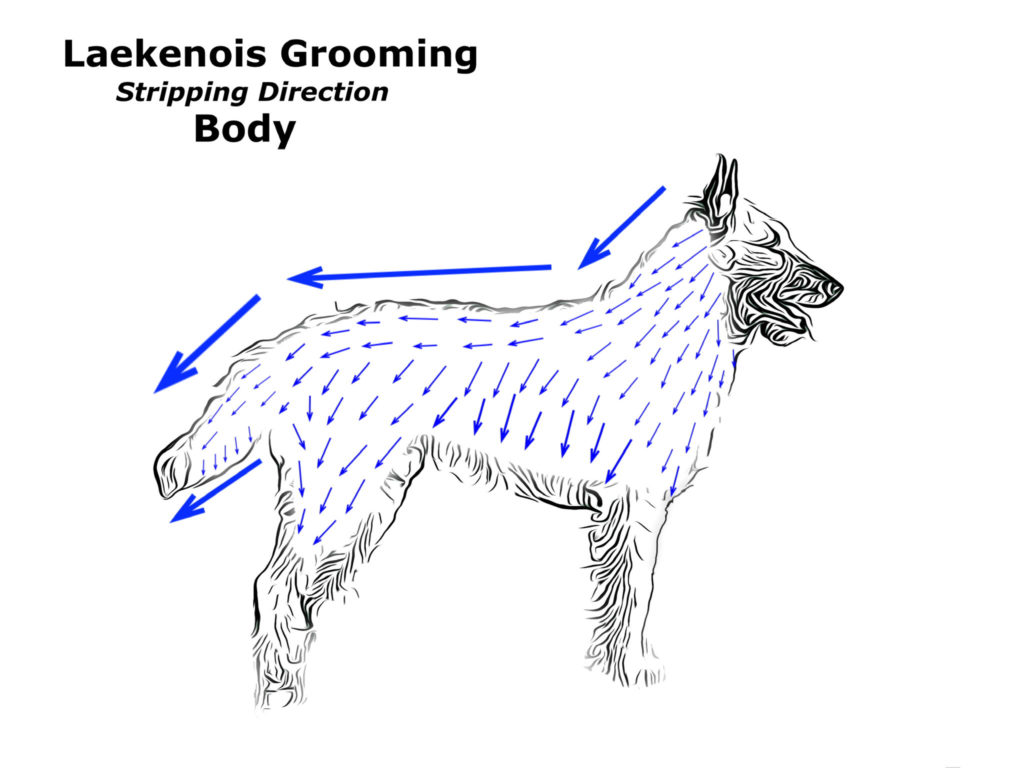
Pull the wire textured topcoat first, if it is the proper time the stripping should reveal a soft undercoat and if the timing right is just below the undercoat will be the new just sprouted top coat
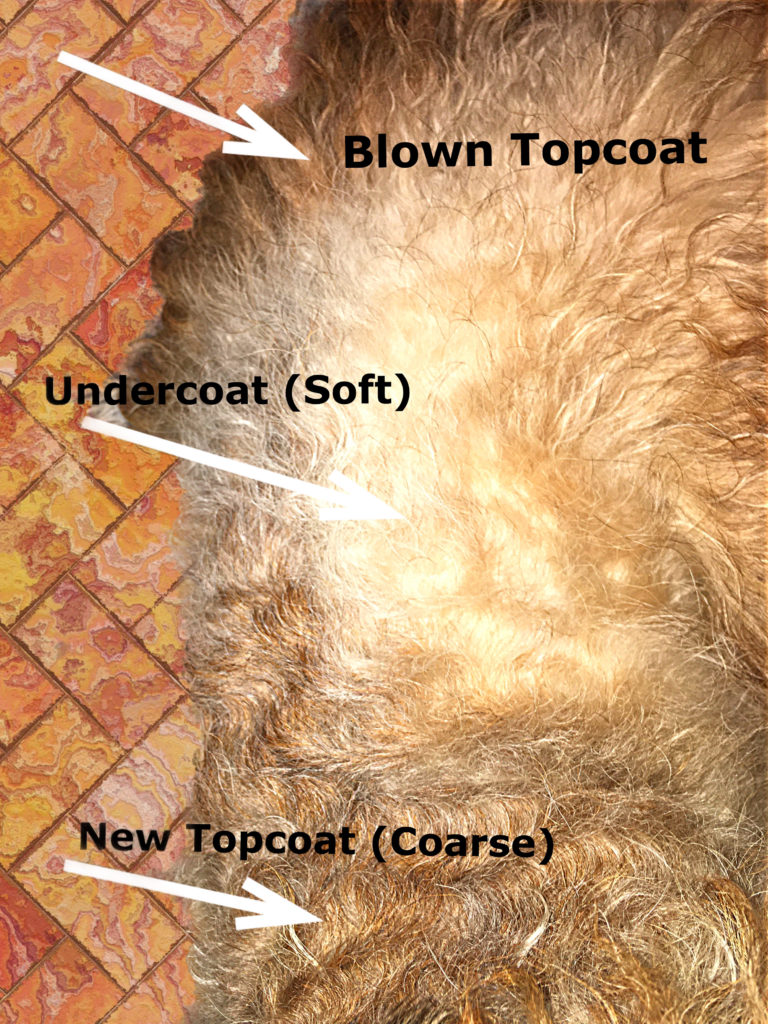
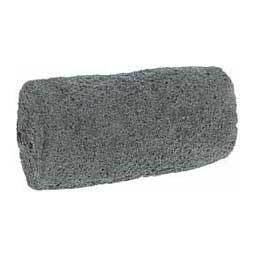
There will be soft undercoat that will need to come out as well, if the undercoat is to difficult to grasp, use a grooming stone made of pumice to collect these fluffy bits
- Once your stripping of the body is complete, your dog will appear much smaller than when you started, especially of the coat was completely blown
FLATWORK THAT IS NOT FLAT
Flatwork is a term in most stripped breeds includes the head, cheeks, ears, jaw line and down the neck line. Although these areas need attention in a Laekenois the coat will NOT be flat as it is in may other breeds that are hand stripped. Having a photo of the headpiece of a dog that is correctly groomed can be a helpful guide as you proceed through the stripping process.
Head – The goal of show grooming is to manage the coat so that the lines of the back skull and muzzle are seen, as well as assuring the eyes are not covered. The overall coat length should be such that the moderate stop is visible.
AKC Standard Head: Clean cut and strong, long without exaggeration and lean. The skull and muzzle are approximately the same length with at most a very slight advantage for the muzzle. Overall size should be in proportion to the body.
AKC Standard Skull – is flattened rather than rounded with the width approximately the same, but not wider than the length. The stop is moderate.
AKC Standard Muzzle – is moderately pointed, avoiding any tendency to snipiness, and approximately equal in length to that of the topskull.
A good description from our friends at Purebred Dog Day
Snipy (or snipey) can refer to a head, but for this post, it also refers to a weak, pointed muzzle lacking in substance in a dog’s under jaw, or fill beneath its eyes. A snipey muzzle is considered too pointed for a dog’s breed type because it lacks depth or width. We’ve heard some people go so far as to describe a snipy muzzle as having the appearance of a dog that stuck its nose in a pencil sharpener, or one that could suck a peanut out of a bottle. Ouch.
The head should not be groomed as a terrier or schnauzer with eyebrow triangles and coat flat on the skull, nor should it be groomed as the lamb-like Bedlington Terrier full of curves where no stop is visible. Nor should there be a part down the center of the muzzle. The head should not be blocky like a Boxer. Think tousled as you work the head The coat is shorter on the head than one might imagine.

Blocky Head or Improper Grooming?
Which is it? You will not be able to tell unless you are able to touch the head to feel the actual structure.
A good head can be hidden by an improper grooming. For example the head with the lego-like rectangles as depicted in the photo may be a head lost among the hair, if you will.
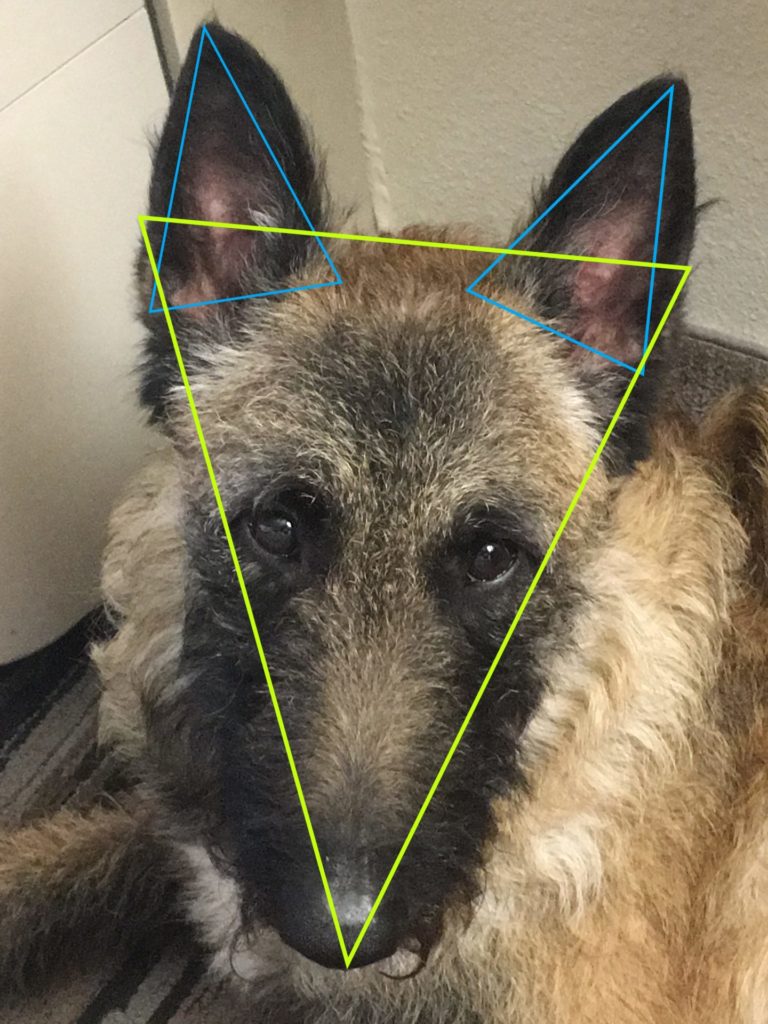
This Laekenois head is composed of triangles. Which is the proper underlying shape for a Laekenois.
The Earline on this dog shows the ear fluff that needs to be removed. It should be removed enough to reveal a clean ear line to define the edges of the ears.
Strip the head in small amounts at a time, grasping hairs near their tips. Work in a patient manner and step back to check your work frequently. Remove all the dead hair from the top of the backskull down to between the eyes, and to the eyes outside edges, being sure not to leave any eyebrows. Work the beard gingerly, leaving as much as possible as it is the slowest portion of the haircoat to grow. Be sure to strip in a manner that the moderate stop is visible. The head should not be groomed to like a collie with an imperceptible stop.
Cheeks – The goal is to have a fairly uniform length of coat on the head, shorter than the body, cheeks are not addressed in the manner of a terrier, the cheeks are not to be carved or chiseled. Keep in mind the tousled look and blending the individual hair onto a flowing melange of hair rather than an assembly of shapes like rectangles and triangles that many stripped breeds require.
Ears – The goal is to have a triangular ear with short coat with a clean edge and outline as well as a clean stripped ear canal area. The ear can be cleaned with a veterinary approved ear solution and a cotton ball.
AKC Standard Ears – are triangular in shape, stiff, erect, and in proportion to the head in size. Base of the ear should not come below the center of the eye.
- The ear backside should be stripped last. 2 weeks or a little more before the show you will need to check the ears to assure that the regrowth is short. The triangular ear shape is clear and crisp with a defined edge. Take the dead ear hair off by hand. The ears should never be scissored or clippered. Using a pumice stone stick is acceptable to neatening the back of the ear leather.
- For the ear canal Corn starch is excellent for preparing to take hair from inside the ear area if need be where a forceps tweezers works well or using your hands is also very effective. Sprinkle a little cornstarch in the ear and then pull, do a few hairs at a time. This method is far more comfortable for the dog that stripping without corn starch
THE FURNISHINGS & BEARD – Laekenois Minimalism
Furnishings in many stripped breeds refer to the Legs, Beard and Eyebrows. In the Laekenois the only one of these two that require attention that apply is the beard and the legs.
Beard- In the Laekenois the beard is comprised from lower jaw. There is not a part down the center of the muzzle with coat blending from the upper jaw to the lower jaw with great length. Stripping to maintain the bottom line of the beard in parallel with the bottom jawline is the correct method and requires some advanced planning. The beard length is relatively short but must be there as per the standard. A specific length cannot be specified as the beard must be in proportion to the head.
The beard must be kept clean and the amount managed with stripping, a pumice stone works nicely as the beards tend to be a bit softer coat. Brushing the beard daily with a small slicker brush is an effective method for keeping mats and debris from making the beard a mess.
Eyebrows- Laekenois do not have eyebrows to trim as a terrier would. The eyebrow hairs should simply blend to enhance the backskull plane. Never should the eyebrows cover the eyes in the manner of Schnauzer or Scottish Terrier.
Legs – can be simply brushed and left as is. If legs require neatening a scissors should not be used, a pumice stone or mars coat king, the original with 12 blades or less for heavier furnishing or your fingers will do the job nicely. The Mars Coat Kings with more blades tend to be too tight an may pull in a painful manner.
ROLLING A COAT
When the Laekenois new top coat has grown in it may be possible to prolong its show life and delay the next stripping by a technique known as rolling. By selectively picking and pulling out the longest hairs that go beyond the outline of the dog. This regular pulling initiates new coat layers by breaking up the first coat into several lengths. Be sure not to take too many hairs in one area. Rolling is not always effective and is dependent on the coat type of the individual dog.
